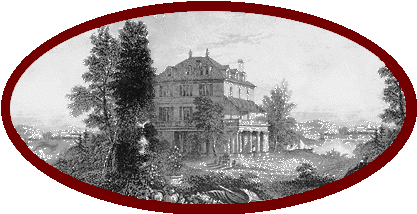


|
In the summer of 1816, Lord Byron rented the Villa Diodati, overlooking
Lake Leman, in the Swiss village of Cologny. Throughout the summer, Byron
and his physician/companion John Polidori were joined by Claire Clairmont,
Percy Bysshe and Mary Wollstonecraft Shelley. It was here that a famous
story-telling contest served as the impetus for Mary Shelley's
Frankenstein. A virtual reincarnation of the Villa Diodati is now open for visits as part of the "Romantic Circles" website, devoted to the study of Lord Byron, the Shelleys, John Keats, and their contemporaries. The virtual villa is a five-room MOO-space, located in the virtual world of Emory MOO at Emory University and consists of an entry and a public chat room, a featured work room, an events room, and a balcony. The MOO is ideally suited for the revival of the literary "salon" online. (An upgraded version of the virtual villa will be accessible this month.)  The virtual villa is part of the "Central Exchange" section, designed as a place for sharing professional information and engaging in discussion or debate. "Central Exchange" also provides a publications page, listing newly published works in the field, a features page, which will present reports from around the world on work being done in Romantic Studies, and a conference page. The two other main sections of the site are "Scholarly Resources" and "Electronic Editions." The former will strive to provide users with comprehensive lists of existing, recent, and forthcoming monographs in Romantic Studies; these include a bibliography of newly published work on all authors and topics related to the site, as well as a listing of all dissertations in progress on these authors and topics. The "Electronic Editions" section, meant to grow into a searchable archive of electronic texts (some in hypermedia format) is edited according to high scholarly standards. Among the electronic texts available so far are Steven E. Jones' hypertext version of Mary Shelley's 1826 novel The Last Man and a hypertext edition of Percy Bysshe Shelley's "The Devil's Walk," edited by Donald H. Reiman and Neil Fraistat.  Since onscreen reading is rarely enjoyable and users probably wouldn't be interested in reading a triple-decker novel online, the hypertext is designed as a supplement to reading the novel in print form--users ccan, for example, access particular chapters they are concentrating on in order to follow links to contextual and intertextual materials. The electronic text of the novel is fully searchable, returning results in a form that preserves hyperlinks.  "Romantic Circles" already provides excellent scholarly resources, and hopefully, further hypertext editions of the same high quality will become available in the future and extend the circle. |